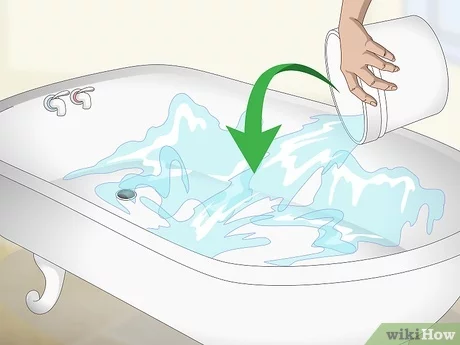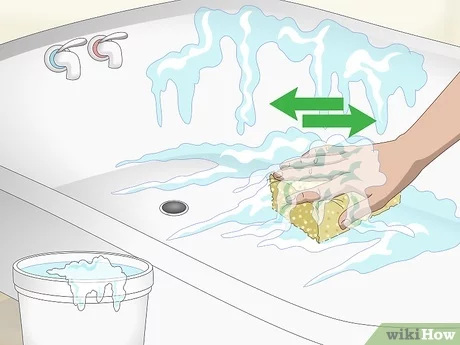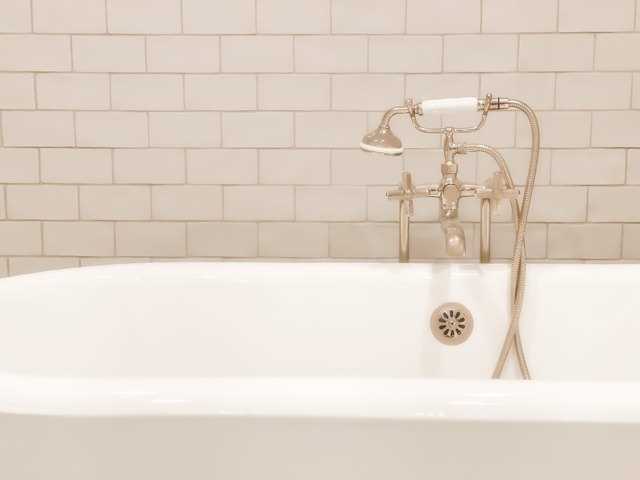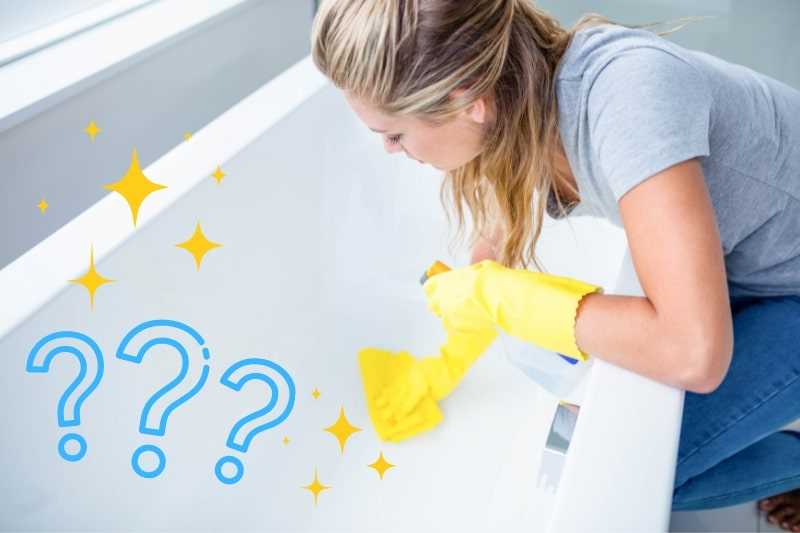


Keeping your enamel bath clean and spotless is essential for maintaining its beauty and longevity. Enamel baths are known for their smooth and glossy surface, but over time, they can become stained and dull. In this ultimate guide, we will walk you through the steps to effectively clean your enamel bath and restore its shine.
Gather Your Cleaning Supplies
Before you start cleaning your enamel bath, gather all the necessary supplies to make the process easier and more efficient. You will need a soft sponge, a non-abrasive cleaner specifically designed for enamel surfaces, baking soda, vinegar, a toothbrush, and a microfiber cloth.
Using Non-Abrasive Cleaner
Start by applying a non-abrasive cleaner to the surface of your enamel bath. Make sure to follow the instructions on the cleaner and use a soft sponge to gently scrub away any dirt or stains. Avoid using abrasive cleaners or scrub brushes, as they can scratch the surface of the enamel and cause more damage.
Pro Tip: For tough stains, create a paste by mixing baking soda with water and apply it to the stained area. Let it sit for a few minutes before scrubbing with a soft sponge or toothbrush.
Removing Soap Scum and Hard Water Stains
If your enamel bath has soap scum or hard water stains, vinegar can be an effective solution. Fill a spray bottle with equal parts vinegar and water, and spray it onto the stained areas. Let it sit for a few minutes, then scrub with a soft sponge or toothbrush. Rinse the bath thoroughly with water to remove any vinegar residue.
Drying and Polishing
After cleaning your enamel bath, make sure to dry it thoroughly with a microfiber cloth. This will help prevent water spots and keep the surface looking shiny. If desired, you can also apply a coat of enamel-safe polish to further enhance the shine and protect the surface from future staining.
By following this ultimate guide, you can keep your enamel bath looking immaculate and enjoy its beauty for years to come.
Why Cleaning an Enamel Bath is Important
Keeping your enamel bath clean is not only important for maintaining its aesthetic appeal but also for ensuring the longevity and functionality of the bath. Regular cleaning can help prevent the build-up of dirt, grime, and soap scum, which can be unsightly and difficult to remove if left untreated.
Preventing Damage

Enamel baths are typically made from a layer of porcelain enamel bonded to cast iron or steel. This enamel coating provides a smooth and glossy finish that is not only pleasing to the eye but also resistant to stains and scratches. However, over time, if the bath is not properly cleaned and maintained, the enamel coating can become damaged.
- Scratches: Dirt and abrasive cleaning products can cause scratches on the enamel surface, which not only detracts from the appearance of the bath but also provides an environment for bacteria to thrive.
- Stains: Mineral deposits from hard water and the residue from soaps and shampoos can leave unsightly stains on the enamel surface. These stains can be difficult to remove and may require professional cleaning if left untouched for an extended period.
- Chipping: Neglecting to clean an enamel bath can result in the build-up of grime and dirt around the edges and corners. This can lead to the enamel coating chipping away, leaving the underlying metal exposed and vulnerable to corrosion.
Prolonging Lifespan

Regular cleaning and maintenance can help prolong the lifespan of your enamel bath, ensuring that it remains in good condition for years to come.
- Cleaning allows you to identify any minor issues or damage that may require repair before they escalate into major problems.
- Preventing the build-up of limescale and mineral deposits can help improve the efficiency of your bath’s water flow and prevent blockages in the drain.
- By keeping your enamel bath clean, you can also eliminate any unpleasant odors that may develop from the accumulation of dirt and bacteria.
Overall Hygiene
Regular cleaning of your enamel bath contributes to overall hygiene in your bathroom.
- Removing dirt, soap scum, and bacteria from the surface of your bath helps to maintain a clean and hygienic environment.
- Regular cleaning can also help prevent the growth of mold and mildew, which thrive in damp environments and can be harmful to your health.
- By keeping your enamel bath clean, you can ensure that it is a welcoming and inviting space for relaxation and self-care.
Overall, cleaning an enamel bath is essential for maintaining its appearance, preventing damage, prolonging its lifespan, and ensuring proper hygiene in your bathroom. Regular cleaning and maintenance will not only keep your enamel bath looking spotless but also contribute to a clean and healthy environment for you and your family.
Step-by-Step Guide to Clean your Enamel Bath
1. Gather Your Supplies

Before starting, gather all the necessary supplies for cleaning your enamel bath. You will need:
- Gentle enamel cleaner
- Soft sponge or cloth
- Old toothbrush
- Baking soda
- Vinegar
- Water
2. Remove any Loose Debris
Use a soft brush or cloth to remove any loose debris, such as hair or dirt, from the bath.
3. Prepare the Cleaning Solution
Mix equal parts of baking soda and water to form a thick paste. Apply the paste to the stained areas of the enamel bath.
4. Scrub the Stains
Using a soft sponge or cloth, scrub the stained areas of the enamel bath with the baking soda paste in a circular motion. Apply gentle pressure to remove the stains.
5. Rinse with Vinegar
Fill a spray bottle with white vinegar and spray it onto the enamel bath. Allow the vinegar to sit for a few minutes, then rinse off with warm water.
6. Clean the Overflow and Drain
Use an old toothbrush or a small scrub brush to clean the overflow and drain of the enamel bath. Make sure to remove any build-up or residue.
7. Rinse and Dry
Rinse the entire enamel bath with warm water to remove any remaining cleaning solution or vinegar. Use a clean, dry cloth to thoroughly dry the bath.
8. Polish and Protect
Apply a small amount of gentle enamel cleaner to a soft cloth and polish the entire surface of the enamel bath. This will help protect it and keep it looking shiny and new.
9. Repeat as Necessary
If there are still stains or residue on the enamel bath, repeat the cleaning process as necessary until the bath is completely clean and spotless.
10. Regular Maintenance
To keep your enamel bath clean and spotless, make sure to regularly clean it using a gentle cleaner and soft cloth. Avoid using abrasive cleaners or scrub brushes that can damage the enamel surface.
By following these step-by-step instructions, you can effectively clean your enamel bath and keep it looking pristine.
Best Products for Cleaning an Enamel Bath
When it comes to cleaning an enamel bath, it is important to use the right products to ensure effective and safe cleaning. Here are some of the best products that you can use to clean your enamel bath:
1. Enamel Cleaner
An enamel cleaner is specifically designed to remove tough stains and deposits from an enamel surface without damaging it. Look for a cleaner that is specifically formulated for enamel baths and follow the instructions carefully for best results. Apply the cleaner to the surface of the bath, allow it to sit for a few minutes, and then scrub with a soft sponge or brush. Rinse thoroughly with water afterwards.
2. White Vinegar
White vinegar is a natural and non-toxic cleaner that can be used to clean various surfaces, including enamel baths. It has acid properties that can help remove stains and soap scum without causing any damage. Mix equal parts of white vinegar and water and apply it to the bath surface. Let it sit for a few minutes, then scrub with a soft sponge or brush. Rinse thoroughly with water afterwards.
3. Baking Soda
Baking soda is another natural cleaning agent that can be effective in removing stains and residue from an enamel bath. Make a paste by mixing baking soda with water and apply it to the surface of the bath. Leave it for a few minutes, then scrub gently with a soft sponge or brush. Rinse thoroughly with water afterwards.
4. Non-Abrasive Cleaners
There are various non-abrasive cleaners available in the market that are specifically designed for cleaning enamel baths. These cleaners are usually gentle on the enamel surface and can effectively remove stains and deposits. Follow the instructions on the product for best results.
5. Microfiber Cloths
Microfiber cloths are great for cleaning delicate surfaces like enamel baths. They are soft, lint-free, and can help to prevent scratching or damaging the enamel. Use a microfiber cloth along with your chosen cleaning product to gently scrub the bath surface.
6. Rubber Gloves

When cleaning an enamel bath, it is important to protect your hands from harsh chemicals. Wear rubber gloves to protect your skin and prevent any allergic reactions or irritation.
Remember to always read and follow the instructions on the cleaning products for best results. Additionally, it is recommended to test any cleaning product on a small, inconspicuous area of the enamel bath before using it on the entire surface.
Tips to Prevent Stains and Build-Up on your Enamel Bath

- Regular cleaning: One of the most effective ways to prevent stains and build-up on your enamel bath is to clean it regularly. This involves removing any dirt or grime with a gentle cleaner and a soft cloth. By doing this on a routine basis, you can prevent the accumulation of stains and keep your enamel bath looking spotless.
- Avoid abrasive cleaners: When cleaning your enamel bath, it is important to avoid using abrasive cleaners. These cleaners can scratch the surface of the enamel and make it more prone to staining and build-up. Instead, opt for non-abrasive cleaners that are specifically designed for use on enamel surfaces.
- Use a protective mat: Placing a protective mat in your enamel bath can help prevent stains and build-up. The mat helps to create a barrier between the bath and any potential sources of staining, such as bath products or hard water. Be sure to choose a mat that is designed for use in a bath and is easy to clean.
- Wipe dry after each use: After using your enamel bath, be sure to wipe it dry with a soft cloth. This helps to prevent the accumulation of water spots and can reduce the chances of stains and build-up forming. By making this a regular habit, you can keep your enamel bath looking clean and shiny.
- Inspect and repair any chips or scratches: Over time, your enamel bath may develop chips or scratches. These damaged areas can provide a breeding ground for stains and build-up. To prevent this, it is important to regularly inspect your bath for any signs of damage and repair them promptly. You can use a repair kit specifically designed for enamel baths to fix any chips or scratches.
- Use vinegar for hard water stains: If your enamel bath is prone to hard water stains, you can use vinegar to remove them. Simply mix equal parts vinegar and water in a spray bottle, spray the solution onto the stained areas, and let it sit for a few minutes. Then, scrub the stains with a soft cloth or sponge and rinse thoroughly. Vinegar is a natural and effective cleaner for hard water stains and can help keep your enamel bath looking clean.
- Consider a water softener: Installing a water softener can help prevent the build-up of minerals and reduce the chances of staining in your enamel bath. Hard water contains a high concentration of minerals, such as calcium and magnesium, which can leave behind deposits on your bath surface. A water softener works by removing these minerals, ensuring that your enamel bath stays clean and free from build-up.
Common Mistakes to Avoid when Cleaning an Enamel Bath
When it comes to cleaning an enamel bath, it’s important to avoid certain mistakes that can damage the delicate surface. Here are some common mistakes to avoid:
1. Using abrasive cleaners
Avoid using abrasive cleaners or scrub brushes on your enamel bath as they can scratch the surface and leave behind visible marks. Opt for non-abrasive cleaners specifically designed for enamel surfaces.
2. Using harsh chemicals

Harsh chemicals like bleach and ammonia can cause discoloration and damage to the enamel. Instead, use mild, non-toxic cleaners that are safe for use on enamel baths.
3. Neglecting regular cleaning

Regular cleaning is essential to maintain the cleanliness and shine of your enamel bath. Neglecting regular cleaning can lead to the buildup of dirt, grime, and soap scum, which can be more difficult to remove in the long run.
4. Using rough scrubbing pads
Avoid using rough scrubbing pads or abrasive materials to clean your enamel bath. These can cause scratches and damage the enamel coating. Instead, opt for soft sponges or microfiber cloths for gentle cleaning.
5. Leaving cleaning products on the surface for too long

When cleaning your enamel bath, do not leave cleaning products on the surface for an extended period. This can cause the products to dry out and leave behind residue or stains. Always rinse the surface thoroughly after cleaning.
6. Using excessive force
Enamel is a delicate material, and using excessive force while cleaning can cause chips, cracks, or other damage. Be gentle while scrubbing and avoid putting too much pressure on the surface.
7. Neglecting to dry the surface properly
After cleaning your enamel bath, it’s important to dry the surface properly to prevent water spots and mineral deposits. Use a soft towel or cloth to dry the bath thoroughly after cleaning.
By avoiding these common mistakes, you can ensure that your enamel bath remains spotless and in top condition for years to come.
FAQ
What are some common stains that can appear on an enamel bath?
Some common stains that can appear on an enamel bath include soap scum, hard water deposits, rust stains, and mineral buildup.
What tools and materials do you need to clean an enamel bath?
To clean an enamel bath, you will need a soft cloth or sponge, mild detergent, vinegar or lemon juice, baking soda, a non-abrasive cleaner, a soft brush or toothbrush, and a towel or cloth for drying.
How often should I clean my enamel bath?
It is recommended to clean your enamel bath at least once a week to prevent the buildup of stains and grime. However, if you notice any visible stains or dirt, it is best to clean it as soon as possible.
Can I use abrasive cleaners on an enamel bath?
No, you should avoid using abrasive cleaners on an enamel bath as they can scratch the surface and cause damage. It is best to use non-abrasive cleaners and gentle cleaning methods to ensure the longevity of your bath.











